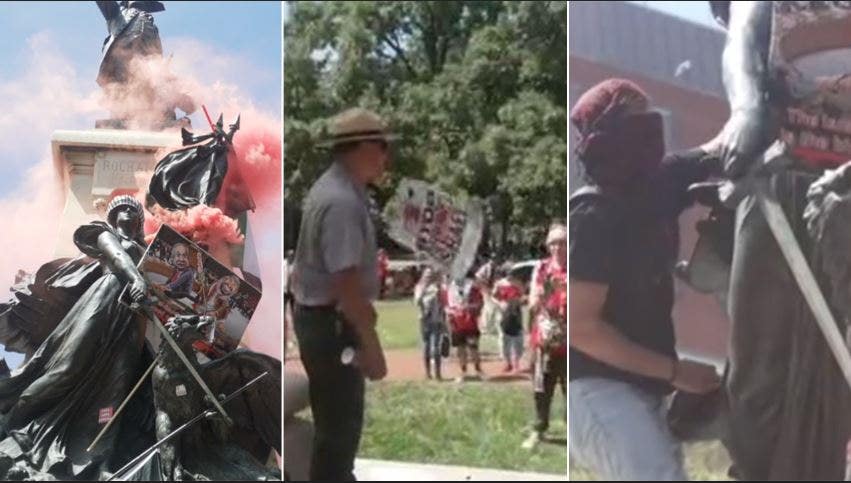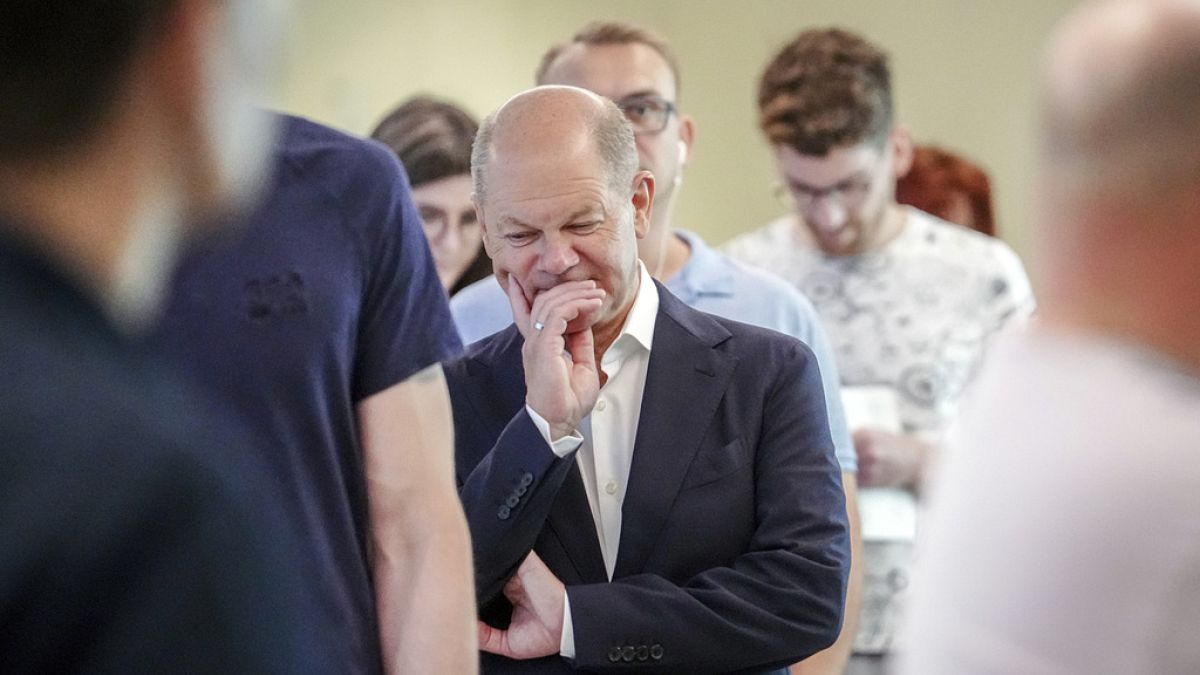Virginia
Road Tripping Through Virginia to Understand America’s Complex Past

This difficult history became even clearer in Richmond, our ultimate destination. Iconic Monument Avenue stretches for five miles, reminiscent of the National Mall and lined in parts with distinguished homes and beautiful historic architecture. It is marked by circular flowerbeds and enclosures where Confederate monuments once stood, including the twelve-ton bronze and marble statue of Robert E. Lee, who led the defeated Southern troops, was stripped of his American citizenship as a traitor, and has been venerated to this day in public spaces too numerous to count. The Monument Avenue statues that were graffitied during the summer 2020 protests are now laid out meticulously in Richmond’s water treatment facility, the only municipal space large enough to hold them. That is where I saw them. They form a graveyard of Confederate monuments.
While in Richmond, I met Devon Henry, whose general contracting company took down the Lee monument. During our conversation, I learned he was the same general contractor who built the Memorial to Enslaved Laborers at the Jefferson-designed University of Virginia during 2019 and 2020. It honors the 4,000 enslaved people who worked on the campus.
Henry and I talked next to the Shockoe Hill African Burying Ground, the biggest Black cemetery I have ever seen. It lies in the leafy neighborhood of Gilpin, but was divided from the historic Black community of Jackson Ward by construction of I-95. Henry had joined me because he will be working there with Richmond sisters Enjoli J. Moon and Sesha Joi Moon and their JXN Project, which is reconstructing a building—the Skipwith-Roper Cottage—to commemorate Jackson Ward Founding Father Abraham Peyton Skipwith. The original cottage, owned by the formerly enslaved Skipwith in the 18th century and left in his will to his descendants, was forcibly condemned in the 1950s and relocated to the Sabot Hill Plantation, which once belonged to Confederate Secretary of War James Seddon. It’s a reminder that we can’t assume the landscapes we see reflect undisturbed history, or that the structures we encounter convey true stories.
I asked Henry how long it took to remove the Lee monument. He told me he and his contractors studied it for more than a year, with resources ranging from archeologists’ analysis to drone footage. They received death threats; he knew they would have to move fast once the removal began. Ultimately, they lifted the massive statue off its granite pedestal in less than an hour. “From here on, I want to use my talents for this reparative work,” Henry told me, gesturing towards the site where the Skipwith-Roper cottage will stand.
Listening, I considered how even at the magnitude of Richmond’s Monument Avenue, the scale of the UVA campus, or the open space of this cemetery tended by generations of Black families, change cannot happen without the human hand. Through my work with the Mellon Foundation’s Monuments Project, I know American monuments today are part of a collective effort of re-thinking, re-working, and re-imagining: we take some down, we build others up, and in the process, we tell the ever-evolving American story. In this contractor, I met a Virginian who was doing it all.
Throughout the road trip, I meditated deeply on how we think about our dead, and how they inform our beliefs about who we are as a country. At Richmond’s African Burial Ground, I saw again why our choices about who we formally commemorate are important to understand. An unknown number of Black Americans lie on the site of Richmond’s former slave market, where more than 300,000 Black people were tortured, stolen, and sold. An installation will soon mark its history, but the African Burial Ground has always existed in the memory of Richmond’s Black community. Some of the Black Richmonders spoke familiarly, for example, of a man they call Gabriel. Gabriel Prosser was an enslaved blacksmith who in 1800 planned one of the most extensive slave revolts in American history. Betrayed by other enslaved Black people to white slave-owners, he was hung at Richmond’s city gallows, which also stood on the African Burial Ground. The site’s new installation will share Prosser’s story with a broader public, but his descendants and community have never forgotten it.
Leaving Virginia, I thought back on the beautiful Shockoe Hill African Burying Ground, with its trees in fragrant flower. All throughout the cemetery families honor their loved ones, whose stories make up the dynamic history of this country. Its power lies not only in the people it holds and the descendants who remember them, but also in what it reveals to anyone who travels to Virginia.
Elizabeth Alexander is a poet, scholar, and the president of the Mellon Foundation.

Virginia
Virginia Democrat robbed of voice by 'Parkinson's on steroids' is first to use text-to-speech device on House floor
An early-career Virginia Democrat is leaving office following her diagnosis with a disease known as “Parkinson’s on steroids,” but she’s breaking new ground on her way out of the Capitol.
Rep. Jennifer Wexton, who beat a Republican incumbent in 2018 to represent Virginia’s 10th congressional district, announced a year ago that she had been diagnosed with Parkinson’s but insisted she would remain in Congress, Business Insider previously reported.
About six months later, she changed course and announced she would retire at the end of the term.
“I wasn’t making the progress to manage my symptoms that I had hoped,” Wexton said in a statement in September, noting that her doctors “modified my diagnosis to Progressive Supra-nuclear Palsy — a kind of ‘Parkinson’s on steroids.’”
Since then, she became the first member of Congress to address the House floor using an Augmentative and Alternative Communication device that translates text to speech, according to The 19th.
“I hope I can show that even as debilitating a diagnosis as this doesn’t have to mean you are powerless,” Wexton told CNN, using the device. “Whatever your politics, when it comes to illness, ‘progressive’ is not a good thing to be.”
Virginia primaries are set for later this month to determine VA-10’s candidates for the November election, and they are shaping up to be highly competitive. One expert told WAMU, DC’s NPR affiliate, that it could be one of the “most expensive Democratic congressional primaries in the history of Virginia.”
It comes as the state, which Biden won easily in 2020, is turning purple, alarming Democrats and giving hope to supporters of former President Donald Trump.
Virginia
Conspiracy theorist blew up his Virginia home on purpose — while still inside, shocking new body cam footage shows

A conspiracy theorist purposefully blew up his Virginia home while authorities were trying to serve a search warrant in December, according to a new video released by law enforcement.
James Yoo, 56, doused his Arlington home with gasoline to set the fire that caused the massive explosion that people reported hearing from miles away, WUSA9 reported. Yoo was found dead inside the following day.
Six months later, on Saturday, Arlington County officials revealed additional details about the deadly blast and released body camera footage from police officers at the scene showing the dramatic moment the house was completely leveled in the explosion.
On December 4, a patrol officer was in the area when he heard what sounded like gunshots, officials said. He ran into children at a nearby park who told him they were “scared,” body cam footage shows.
As cops heard more reports of shots fired, officers learned that a man was firing a flare from the back of his duplex window.
Cops tried to make contact with Yoo at his brick home, but he refused to answer the door and continued shooting flares, footage shows.
He fired more than 40 flares in about 25 minutes while barricaded inside.
For two hours, officers remained at the house. Neighbors told officers Yoo is “reclusive” and had recently covered his windows with black trash bags, tossed garbage into his backyard and covered the trees on his property with toilet paper, officials said.
After learning from relatives Yoo has a history of mental illness, police obtained a search warrant to recover any weapons inside the home, and more officers and negotiators arrived at the house. They told him to surrender, but Yoo refused.
Video shows an armored vehicle pull into the driveway and breach the front door. Several gunshots were heard from inside the home and officers at the scene can be ducking for cover. Police then deployed tear gas inside the home in the hopes Yoo would finally give up, but to no avail.
“James … I’m going to need you to come out slowly with your hands raised,” a cop yells towards the home in the video.
Just as police prepared to breach a window, the home suddenly exploded violently, sending debris flying in all directions.
After police confirmed all emergency responders were safe, cops can be seen pounding on neighbors’ doors and evacuating them. Yoo’s residence continued to burn.
The next day, remains belonging to Yoo were discovered where the house once stood. Investigators additionally found gasoline canisters, three guns, two flare guns, magazines, ammunition and spent flares at the scene.
Before his apparent suicide,Yoo reportedly posted on social media paranoid rants about his neighbors and a former co-worker on his now-disabled LinkedIn account.
He spread rambling and at times incoherent conspiracy theories against government officials, law enforcement, media outlets and his neighbors, whom he accused of being spies and collecting his personal information for unspecified handlers, CNN reported.
Yoo also filed lawsuits against his ex-wife, younger sister, a moving company and the New York Supreme Court for being committed to a hospital against his will. The suits were dismissed as frivolous.
Virginia
Street Vibrations: Spring Rally in Virginia City

RENO, Nev. (KOLO) – The Annual Street Vibrations Spring Rally roared its way into Virgnia City June 8.
Motorcyclists and spectators alike enjoyed live music, fun entertainment and of course motorcycles along the road.
One motorcyclist who has been a member of the American Motorcyclists Association for about 45 years says it’s hard to describe the joy of riding at events like this.
Business owners also love the event saying it helps kick off their summer season, and it’s great to see the people who come back year after year.
Copyright 2024 KOLO. All rights reserved.
-

 World1 week ago
World1 week agoBiden eases ban on Ukraine’s use of US weapons inside Russia
-

 News1 week ago
News1 week agoIn a historic verdict, Trump found guilty on 34 felony counts in “hush money” trial : Consider This from NPR
-

 Politics1 week ago
Politics1 week agoTrump turns conviction into cash, spotlights record fundraising in wake of guilty verdict
-

 Politics1 week ago
Politics1 week agoDe Niro says Trump guilty verdict means 'justice was served'
-

 World1 week ago
World1 week agoEl Salvador’s President Nayib Bukele cements power as he begins second term
-

 Politics1 week ago
Politics1 week agoTales from The Trail: Trump 'unleashed' with criminal trial over
-

 Politics1 week ago
Politics1 week agoFox News Politics: Trump Guilty!
-

 News1 week ago
News1 week ago3 killed, including police officer, in Minneapolis shooting – UPI.com




















